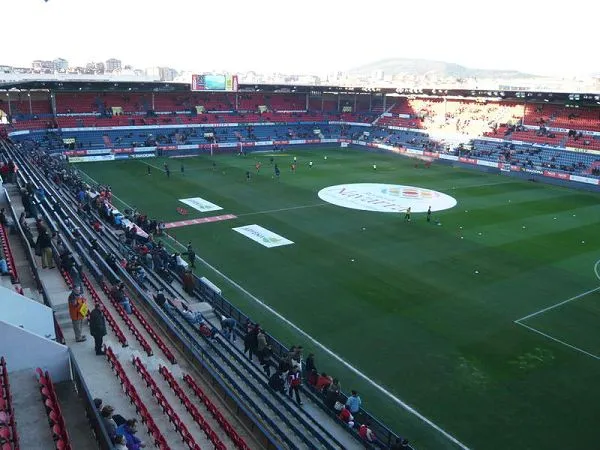- BETTING TIPS
- BETTING TIPS NAVIGATIONS
 Premier League
Premier League FA Cup
FA Cup League Cup
League Cup La Liga
La Liga Copa del Rey
Copa del Rey Super Cup
Super Cup Champions League
Champions League Europa League
Europa League Europa Conference League
Europa Conference League World Cup
World Cup Euro Championship
Euro Championship Nations League
Nations League Africa Cup of Nations
Africa Cup of Nations Copa America
Copa America International Friendly
International Friendly Confederations Cup
Confederations Cup Serie A
Serie A Coppa Italia
Coppa Italia Super Cup
Super Cup Bundesliga
Bundesliga Ligue 1
Ligue 1 DFB Pokal
DFB Pokal Super Cup
Super Cup Malaysia Super League
Malaysia Super League Coupe de France
Coupe de France Trophée des Champions
Trophée des Champions Pro League
Pro League
- Teams
- TEAMS NAVIGATIONS
 Premier League
Premier League FA Cup
FA Cup League Cup
League Cup La Liga
La Liga Copa del Rey
Copa del Rey Super Cup
Super Cup Champions League
Champions League Europa League
Europa League Europa Conference League
Europa Conference League World Cup
World Cup Euro Championship
Euro Championship Nations League
Nations League Africa Cup of Nations
Africa Cup of Nations Copa America
Copa America International Friendly
International Friendly Confederations Cup
Confederations Cup Serie A
Serie A Coppa Italia
Coppa Italia Super Cup
Super Cup Bundesliga
Bundesliga Ligue 1
Ligue 1 DFB Pokal
DFB Pokal Super Cup
Super Cup Malaysia Super League
Malaysia Super League Coupe de France
Coupe de France Trophée des Champions
Trophée des Champions Pro League
Pro League
- Fixtures & Results
- Fixtures & Results NAVIGATIONS
 Premier League
Premier League FA Cup
FA Cup League Cup
League Cup La Liga
La Liga Copa del Rey
Copa del Rey Super Cup
Super Cup Champions League
Champions League Europa League
Europa League Europa Conference League
Europa Conference League World Cup
World Cup Euro Championship
Euro Championship Nations League
Nations League Africa Cup of Nations
Africa Cup of Nations Copa America
Copa America International Friendly
International Friendly Confederations Cup
Confederations Cup Serie A
Serie A Coppa Italia
Coppa Italia Super Cup
Super Cup Bundesliga
Bundesliga Ligue 1
Ligue 1 DFB Pokal
DFB Pokal Super Cup
Super Cup Malaysia Super League
Malaysia Super League Coupe de France
Coupe de France Trophée des Champions
Trophée des Champions Pro League
Pro League
- Tables
- Tables NAVIGATIONS
 Premier League
Premier League FA Cup
FA Cup League Cup
League Cup La Liga
La Liga Copa del Rey
Copa del Rey Super Cup
Super Cup Champions League
Champions League Europa League
Europa League Europa Conference League
Europa Conference League World Cup
World Cup Euro Championship
Euro Championship Nations League
Nations League Africa Cup of Nations
Africa Cup of Nations Copa America
Copa America International Friendly
International Friendly Confederations Cup
Confederations Cup Serie A
Serie A Coppa Italia
Coppa Italia Super Cup
Super Cup Bundesliga
Bundesliga Ligue 1
Ligue 1 DFB Pokal
DFB Pokal Super Cup
Super Cup Malaysia Super League
Malaysia Super League Coupe de France
Coupe de France Trophée des Champions
Trophée des Champions Pro League
Pro League
- News
- News NAVIGATIONS
 Premier League
Premier League FA Cup
FA Cup League Cup
League Cup La Liga
La Liga Copa del Rey
Copa del Rey Super Cup
Super Cup Champions League
Champions League Europa League
Europa League Europa Conference League
Europa Conference League World Cup
World Cup Euro Championship
Euro Championship Nations League
Nations League Africa Cup of Nations
Africa Cup of Nations Copa America
Copa America International Friendly
International Friendly Confederations Cup
Confederations Cup Serie A
Serie A Coppa Italia
Coppa Italia Super Cup
Super Cup Bundesliga
Bundesliga Ligue 1
Ligue 1 DFB Pokal
DFB Pokal Super Cup
Super Cup Malaysia Super League
Malaysia Super League Coupe de France
Coupe de France Trophée des Champions
Trophée des Champions Pro League
Pro League
- Live ScoresLive
Osasuna
SpainVenue

Estadio El Sadar
| City | : | Iruñea |
| Capacity | : | 23,576 |
| Surface | : | Grass |
Club Atlético Osasuna, commonly known as Osasuna, is a historic and passionate football club based in Pamplona, the capital of the Navarre region in Spain. Founded in 1920, the club has long been one of the most revered institutions in Spanish football, particularly due to its strong identity, unwavering local support, and its commitment to battling against the odds in La Liga.
Osasuna’s name, meaning “health” in Basque, reflects the strong, resilient nature of the club and its fans. Despite never having the financial power of Spain's bigger footballing giants like Real Madrid and Barcelona, Osasuna has managed to carve out its own identity in Spanish football through grit, determination, and a never-say-die attitude.
This article will provide an in-depth exploration of Osasuna’s journey throughout the years, its iconic players, its legendary seasons, and its ongoing ambitions to remain competitive in La Liga. Additionally, we will delve into its special relationship with the people of Pamplona and why Osasuna is more than just a football club – it's a symbol of the city’s spirit and pride.
Match Predictions
- Oviedo vs. Osasuna Predictions & Betting Tips on Nov 04 - 04:00 AM
- Elche vs. Real Sociedad Predictions & Betting Tips on Nov 08 - 04:00 AM
- Girona vs. Alaves Predictions & Betting Tips on Nov 08 - 21:00 PM
- Sevilla vs. Osasuna Predictions & Betting Tips on Nov 08 - 23:15 PM
- Atletico Madrid vs. Levante Predictions & Betting Tips on Nov 09 - 01:30 AM
The Early Days – Foundations and Early Success
Osasuna was founded in 1920 as an offshoot of Club Atlético Madrid, with its early years primarily spent in the regional leagues of Spanish football. It was established by a group of students who had a deep love for the sport and a vision of creating a team that would represent Navarre with pride.
In its early years, Osasuna played a key role in the regional football scene, developing a strong local identity. The club’s first major success came in 1935, when it achieved promotion to the Primera División, marking its entry into Spain’s top-tier football.
Osasuna’s first foray into the top division was brief, but it was the beginning of what would become a journey of consistency and resilience. Despite being a relatively small club in terms of financial resources, Osasuna began to build a reputation for being tough, competitive, and always difficult to beat.
The 1980s and 1990s – Osasuna’s Steady Growth
The 1980s and 1990s marked a period of steady growth for Osasuna, as the club solidified its place in La Liga. After spending much of the 1980s in the Segunda División, Osasuna won promotion to La Liga once again in 1990. This time, the club was able to establish itself as a competitive force in Spain’s top division, thanks to solid management and a well-balanced team.
In the 1990s, under managers such as Javier Irureta, Osasuna achieved notable success, finishing in the upper half of the table on several occasions. The club also became known for its highly organized defense, with a style of play that focused on discipline, teamwork, and counter-attacking football.
Osasuna experienced one of its best seasons in the 1990-91 campaign, where the club finished in a respectable 6th position, securing a spot in European competition. The Copa del Rey runs were also memorable, with the club consistently reaching the latter stages of the tournament during this period.
Despite not having the financial resources of larger clubs, Osasuna’s core strength lay in its ability to develop talented players from within its youth ranks, as well as its reliance on solid team structures and teamwork.
The 2000s – A Historic Moment in European Football
The early 2000s were a golden era for Osasuna, with the club reaching new heights in both domestic and European competitions. Under the management of José Ángel Ziganda, Osasuna achieved its greatest achievement in modern history by reaching the semifinals of the 2006-07 UEFA Cup (now the Europa League), a feat that sent shockwaves throughout Europe.
The team’s performances in Europe that season were extraordinary, with wins over the likes of Lazio and Schalke 04, marking a historic achievement for the club. Although Osasuna ultimately fell short of reaching the final, their stunning run in the UEFA Cup was a source of immense pride for the fans and demonstrated that the club was capable of competing with Europe’s best.
Domestically, Osasuna continued to build on its successes, finishing in the upper half of the La Liga standings and earning a reputation for its well-organized defense and counter-attacking play. The 2006-07 season also saw the club finish in 4th place, securing a spot in the Champions League qualifiers for the first time in its history.
Key Players Who Defined Osasuna’s Legacy
Over the years, Osasuna has produced some fantastic footballing talent. Some of the club’s standout players are remembered not only for their individual brilliance but also for their contribution to Osasuna’s success over the years.
Joaquín Caparrós
Joaquín Caparrós was one of the most influential managers in Osasuna’s history. Under his leadership, the club established itself as a competitive force in Spain. He was the architect of Osasuna’s defensive strength and the manager who led the club to the 2006-07 UEFA Cup semifinals.
Raúl García
Raúl García is one of the most iconic players to have ever donned the Osasuna jersey. The talented midfielder, who later went on to achieve success with Atlético Madrid, began his career at Osasuna and became a key figure in the club’s midfield during its most successful years. Known for his vision, passing range, and tenacity, Raúl García played a crucial role in Osasuna’s remarkable 2006-07 season.
Juanfran Torres
Juanfran Torres, who went on to have a successful career at Atlético Madrid, is another legend who made his name at Osasuna. Known for his pace, stamina, and defensive reliability, Juanfran was a fan favorite during his time at the club and played a pivotal role in Osasuna’s rise to prominence in Spanish football.
Patxi Puñal
Patxi Puñal was the heart and soul of Osasuna for over a decade. Serving as the club's captain for many years, the defensive midfielder was known for his leadership, commitment, and work rate. Puñal became a symbol of the club's values and a fan favorite who represented the spirit of Osasuna.
Osasuna’s Style of Play – The Key to Its Success
One of the key characteristics of Osasuna’s success over the years has been its distinctive style of play. The club is known for its highly organized defense, often focusing on a solid backline and counter-attacking football. The team typically relies on a compact formation, with players working together to neutralize the opposition’s attacking threats.
Osasuna has often been a side that thrives on playing for set pieces, delivering dangerous crosses into the box, and capitalizing on aerial duels. The team’s work ethic, discipline, and strong collective ethos have been the foundation of its success.
Although the club may not have the same attacking firepower as Spain’s biggest clubs, Osasuna is able to maintain its competitive edge by being difficult to break down and staying organized throughout the match.
The Future of Osasuna – Ambitions and Challenges
Looking toward the future, Osasuna aims to continue to establish itself as a stable presence in La Liga. While the club's budget is considerably smaller compared to some of the wealthiest clubs in Spain, Osasuna’s strength lies in its community-driven approach, its focus on youth development, and its commitment to building a team that reflects the values of its fans.
In recent years, the club has invested in improving its facilities, including the development of its El Sadar Stadium, and it remains focused on bringing through local talent from the Navarre region. Osasuna’s long-term ambitions include securing consistent top-half finishes in La Liga and making a return to European competition.
For Osasuna to achieve these goals, the club will need to continue focusing on strong team dynamics, tactical discipline, and building on its history of producing high-quality players.
Conclusion: Osasuna – A Club Built on Resilience and Passion
Osasuna may not have the financial power of Spain's top clubs, but its legacy in La Liga and European football is undeniable. With a history that spans over a century, Osasuna has become one of the most respected clubs in Spanish football, known for its relentless work ethic, passionate fanbase, and commitment to community.
Through its remarkable achievements in the 2006-07 UEFA Cup, its fierce rivalries, and its place in the hearts of the people of Pamplona, Osasuna has proven that size and financial backing are not the only ingredients for success. The true spirit of the club lies in the heart of every player and every supporter who continues to believe in the power of Osasuna.
As the club continues to fight for survival in La Liga, it remains a symbol of perseverance and pride, and its future remains full of possibilities.
News & Updates


